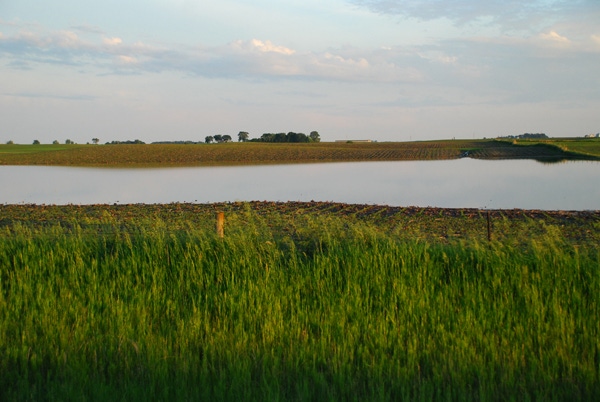November 8, 2011

Unless you grow grapes on an Italian hillside, you probably have experienced cropland flooding at some time. It might have been a pond that dissipated after a week, or it might have been a river that left its banks and completed its deposits on some of your best corn ground. In each case the soil suffers some damage, and even if you are not farming in a river bottom, the lessons learned this year along the Missouri and Mississippi rivers in Iowa, Nebraska and Missouri may be applicable to farmers who fuss with a few ponds in a field.
The Missouri River flooding came at a time when post-flood planting would be difficult to accomplish, and crops would have been less than productive. However, once-flooded land, abandoned for the growing season, suffers says Iowa State University Soil Management Specialist Mahdi Al-Kaisi. He says soils that are left unattended will suffer potential economic and environmental consequences. In a recentnewsletter, he says there are changes that will occur when soils are saturated for an extended period of time and one is a change in the biological health of the soil. Flooding conditions will not only kill growing plants, such as crops and weeds, but will kill the microorganisms found in the soil that contribute to nutrient uptake to growing crops. But he says if plants are growing in the once-flooded soil, they will “help rebuild the microbial community in the root zone, which is essential to nutrient cycling.”
Al-Kaisi reports that flooded soil will suffer from the loss of fungi colonization rates for the next growing season. Known as AM (abbreviation for arbuscular mycorrhizae) fungi, they will create colonies around roots of a host plant, such as corn or soybeans, and their cellular structures will benefit the crop from their increased nutrient uptake in the relationship between the crop’s root system and the AM fungi.
Al-Kaisi also says the flooded soil will suffer some chemical changes resulting from the temporary changes in oxygen supply in the soil. But he says there will be other changes, including rock stability, soil structure, pH and other factors that can be significant without the potential for a growing crop.
In his newsletter, Al-Kaisi makes a number of recommendations to remediate flooded farmland, including the use of a cover crop as soon as the soil can be planted. He says that will help with nutrient cycling, and suggests the use of a crop over the winter to provide additional benefits of continuous growth next spring prior to planting. He says once soils become aerobic, then the microbial activity will resume naturally.
One of the issues is the loss of phosphate in the soil, and Al-Kaisi said the typical tell tale signs will be purple leaves on plants, but he said corn grown on flooded soil should lose any purple leaves within a week. Additionally, “Flooded fields with weeds or without tillage showed less purpling than those tilled to control weeds.” But he said time is needed for the phosphorous to benefit the soil after it has a chance to aerate. However he said flooded fields may have a normal phosphate test and still have a low degree of AM fungi. To alleviate any phosphorous deficiency, he suggests high banded P rates are needed, at least twice as much as the normal rate.
Land that was flooded extensively may benefit from a soil test, which should be conducted after any leveling is done to mitigate gullies and other washes. Soil test results may be surprising if either topsoil has been washed away or other soil has been washed into your field.
Summary
Whether you have long flooded river bottomland or pesky ponds that never seem to dry out, the soil can be damaged from the loss of microbial activity. However, that can be restored with growing plants, such as in a cover crop. The plants and the microbial plants will benefit each other to help the soil regain its dynamic capability. Soil tests will help because flooded land may lose nutrients faster, and flood plains may also gain unknown nutrients.
You May Also Like




